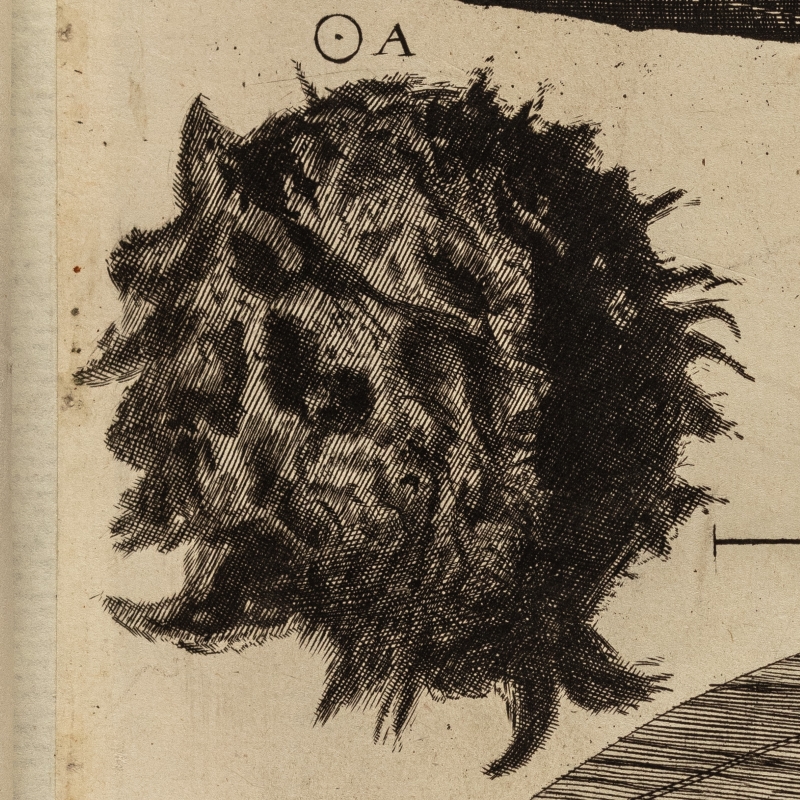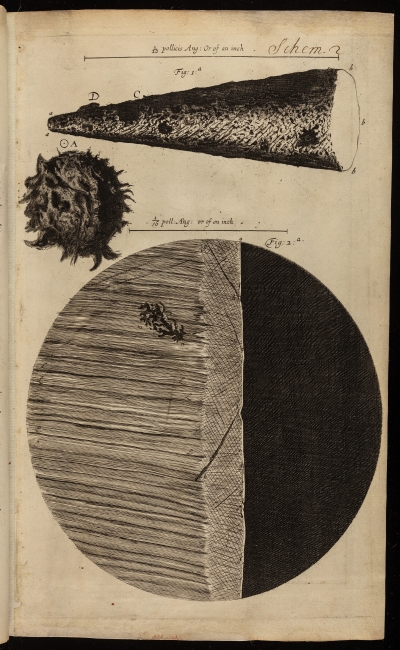Felicity Henderson admires Robert Hooke's 'Micrographia' (1665), praised by Samuel Pepys as 'the most ingenious book that ever I read in my life'.

Robert Hooke’s Micrographia is one of my favourite Restoration books, written by one of my favourite Restoration gentlemen. It’s also extremely important, because it was the first fully illustrated book of microscopy.
The illustrations are one of the main attractions of the book – fantastically detailed and beautifully executed, they still have the same power to impress today as they must have done almost three hundred and fifty years ago. Imagine folding out the super-sized plate with the image of the flea, and seeing for the first time those powerful legs, armour-plated body and hooked claws. Samuel Pepys famously sat up until 2am reading Micrographia, and described it in his diary as 'the most ingenious book that ever I read in my life'. It was probably the pictures that prompted Pepys to buy the book in the first place: he saw a copy at his bookseller’s and found it 'so pretty that I presently bespoke it'.
I suspect we have Charles II to thank in some measure for the high-quality engravings. It was he who requested an illustrated book of microscopy, initially from Christopher Wren, who had begun making such drawings at Oxford. He had presented some to Charles, who liked them so much he asked the Royal Society for more. Wren was busy with other projects and the job fell to Hooke to complete. I particularly like the point he makes with his first plate of observations.

Needle tip, printed full-stop and razor’s edge, from Robert Hooke’s Micrographia (London, 1665).
Here Hooke starts at the very beginning, with the two basic geometric units, the point and the line. But because he’s doing microscopy rather than geometry, the point is illustrated by the tip of a needle (top image above) and a printed full-stop (central image), and the line is the edge of a razor (bottom image). Hooke’s purpose in this plate is to demonstrate to his readers the microscopic irregularities in things the human eye perceives as regular, sharp, and smooth. So the tip of the needle is rounded and blunt, the razor’s edge pitted and scarred, and the full-stop is a chaotic blot 'like a great splatch of London dirt'. According to Hooke, it’s tedious to look at man-made things through the microscope, because they all turn out to be the same – gross, clumsy and irregular. In his own words: 'the Productions of art are such rude mis-shapen things, that when view’d with a Microscope, there is little else observable, but their deformity'.
So he turns to the natural world, and everywhere he looks he sees things that are perfectly formed and perfectly suited to their purpose. 'In natural forms, there are some so small, and so curious, and their design’d business so far remov’d beyond the reach of our sight, that the more we magnify the object, the more excellencies and mysteries do appear'. One of the reasons Micrographia was so influential was that Hooke wasn’t content just to look at the forms of natural objects and draw them; he wanted to understand their 'design’d business' – that is, why they were formed in that way, and what effect it had. One of Micrographia‘s claims to fame is that Hooke used the word ‘cell’ here for the first time to describe the tiny pores he observed in a slice of cork and in the pith of other plants. He compared them with the cells in honeycomb. As soon as he saw them, said Hooke, he realised they explained 'all the phenomena of Cork': that is, its exceeding lightness, its 'springiness and swelling nature', and its imperviousness to air and water.
He went on to describe and explain the microscopic forms of dozens of other everyday plant and insect specimens, including mould, stinging nettles, spiders, ants, mites, flies, poppy-seeds, fish scales, feathers, hair, petrified wood, and 'the Eels in Vinegar' (nematode worms). His observations and descriptions are really interesting (but much too long to reproduce here) so I encourage you to read some of them yourselves. Hooke’s text is extremely lively and readable, and you get a good impression of the man behind the microscope.
Partly, this is because Hooke takes the time to explain some of the difficulties he encountered while doing his observations. The ant, he says, was 'a creature, more troublesom to be drawn, then any of the rest’ because it would not lie still: ‘whilst it was alive, if its feet were fetter’d in Wax or Glew, it would so twist and wind its body, that I could not any wayes get a good view of it; and if I killed it, its body was so little, that I did often spoile the shape of it'. Hooke’s solution was to drop it in alcohol, which stunned it for about an hour; until 'upon a sudden, as if it had been awaken out of a drunken sleep, it suddenly reviv’d and ran away'.'
Hooke also commented on the difficulty in correctly interpreting what he could see – the same object looked very different in different lights. 'For it is exceeding difficult in some Objects, to distinguish between a prominency and a depression, between a shadow and a black stain, or a reflection and a whiteness in the colour. … The Eyes of a Fly in one kind of light appear almost like a Lattice, drilld through with abundance of small holes … In the sunshine they look like a Surface cover’d with golden Nails; in another posture, like a Surface cover’d with Pyramids; in another with Cones'.
I love the way Hooke uses a rich vocabulary of descriptive language to complement his illustrations. I think he really wanted his readers to experience for themselves the beauty and complexity in the microscopic details of ordinary things. As he says in his preface, the microscope (and the telescope) allow us to discover completely new worlds, previously unimagined – and Micrographia does a great job of conveying Hooke’s excitement and wonder as he voyaged into the unknown.
[This post was originally posted, in a slightly different format, on Felicity’s blog Robert Hooke’s London]

